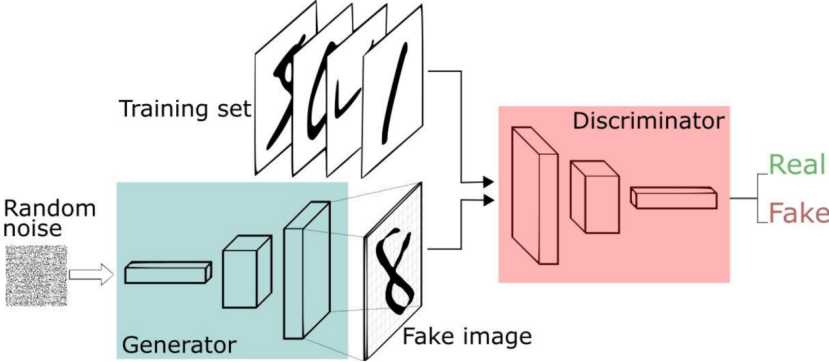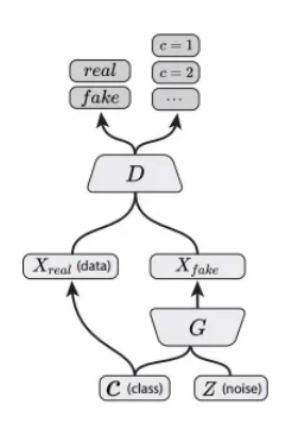Labs Introduction
The generation of image data has always been a challenging task in the field of computer vision. Traditional methods for generating image data are usually based on mathematical models, making it difficult to create realistic images. With the emergence of deep neural networks and large-scale datasets, significant progress has been made in image generation and synthesis tasks. However, traditional generative models, such as autoregressive models and variational autoencoders, face issues such as generating samples that are not realistic enough, severe blurriness, or lack of diversity. Generative Adversarial Networks (GANs), as a powerful image generation model, have achieved remarkable results in various fields such as computer art, medical imaging, virtual reality, and game development.

Author: Huang Mengqin
Organization: China Mobile Smart Home Operation Center
Part 01● Principle of GAN Networks●
The Generative Adversarial Network (GAN) is a deep learning model composed of a generator G and a discriminator D, which generates realistic images through adversarial training.
The goal of the generator G is to learn to produce fake samples that resemble real images, while the goal of the discriminator D is to distinguish the difference between real images and the fake samples generated by the generator. These two networks compete and cooperate with each other, allowing the generator G to gradually improve its capability to generate realistic images, while the discriminator D guides the training of the generator G by distinguishing between real and generated samples.
The architectural diagram of the Generative Adversarial Network is as follows:

-
Generator G:The generator G takes a low-dimensional random vector as input (commonly referred to as a latent space vector) and outputs a fake sample that resembles a real image through a series of transformations and processing. The goal of the generator G is to make the generated samples pass the discriminator D’s judgment and be considered real images.
-
Discriminator D:The discriminator D takes real image samples and fake samples generated by the generator G as input, distinguishing them through judgment and classification. The goal of the discriminator D is to accurately identify the differences between real images and generated samples, making the generated samples closer to real images.
The training process of the Generative Adversarial Network is as follows:
(1) Initialize the parameters of the generator G and discriminator D.
(2) Generate corresponding fake samples using the generator G based on real image samples.
(3) Input the real image samples and generated fake samples into the discriminator D and calculate their discrimination results.
(4) Calculate the loss functions for the generator G and discriminator D based on the output results of the discriminator D.
(5) Update the parameters of the generator G and discriminator D to minimize the loss functions through optimization algorithms (such as gradient descent).
Repeat steps (2)-(5) to gradually optimize the generator G and discriminator D, making the generated samples increasingly realistic.
The loss functions for the generator G and discriminator D are as follows:

The generator G aims for the generated fake samples to be judged by the discriminator D as real images, thus the loss function for the generator G can be defined as the negative of the discriminator D’s misjudgment degree of the generated samples, i.e., maximizing the output results of the discriminator D for the generated samples. The discriminator D aims to accurately distinguish real images from generated samples, and its loss function can be defined as the difference between the output results of the discriminator D for real samples and 1, and for generated samples and 0.
Part 02● Development of GAN Networks ●
Due to the issues of poor image quality caused by mode collapse and unstable training in traditional GAN networks, researchers have made several improvements in the loss functions and network principles to enhance their generation effects and stability.
In terms of network principles, DCGAN (Deep Convolutional GAN) introduced convolutional neural networks as the main structure for the generator and discriminator, effectively capturing spatial features in images and improving the quality of generated images. DCGAN constructs the generator and discriminator through multiple layers of convolutional and transposed convolutional layers and uses batch normalization to stabilize the training process. The improved architectural diagram is shown below:

ACGAN (Auxiliary Classifier GAN) further improved the structure of the discriminator by adding classification conditions, enabling it to function as a classifier that not only discriminates between real and generated samples but also infers the category of the generated samples. This improvement effectively controls the category and diversity of generated samples, allowing GAN networks to generate images that transition from unsupervised to directed control, enhancing GAN’s performance in multi-category generation tasks. The improved architectural diagram is shown below:

In terms of loss functions, traditional GANs use a least-squares loss function based on JS divergence, but this loss function can easily lead to gradient vanishing or explosion issues during training for both the generator and discriminator. To address this issue, several GAN models have been proposed to improve the loss functions.
Among them, WGAN (Wasserstein GAN) proposed using Wasserstein distance to measure the difference between generated samples and real samples, which can better guide the training of the generator. WGAN achieves stable gradient calculation by constraining the weight range of the discriminator and improves generation effects through adversarial training. Its loss function is:

To further enhance the convergence of the loss function, WGAN-GP (Wasserstein GAN with Gradient Penalty) introduces a gradient penalty term based on WGAN, addressing some limitations in the WGAN training process, such as weight clipping and convergence issues. By penalizing the gradients of the discriminator between real and generated samples, WGAN-GP improves gradient calculation and the training of the generator. Its loss function is:

In summary, GAN networks enhance generation effects and stability through improvements in loss functions and network principles. WGAN and WGAN-GP improve the loss functions of traditional GANs, addressing issues of gradient vanishing and explosion. DCGAN and ACGAN enhance network principles by introducing deeper convolutional neural networks and classifier structures, improving the quality and diversity of generated images. These improvements are significant for advancing the development and application of GAN technology.Part 03● Applications and Summary of GAN Networks ●
The application of GAN networks in image generation is not limited to generating rich image samples; they can also expand datasets by generating images, providing more training samples for data-driven tasks.
➢ In data augmentation and sample generation, GAN networks can generate synthetic image samples through the generator network, thus expanding the training dataset. For tasks with insufficient training samples, such as few-shot learning, small-sample learning, and zero-shot learning, generating new samples through GAN networks can improve training effects and the model’s generalization ability. This application scenario is significant for computer vision tasks, object detection, image classification, etc.
➢ In facial expression generation and recognition, GAN networks can generate facial images with different expressions for training facial expression generation and recognition tasks. The generator network can learn to produce realistic facial images with different expressions, thus expanding the training dataset and providing more samples for training facial expression recognition models. This is significant for fields such as facial recognition and sentiment analysis.
➢ In completing deep learning model training tasks, images generated by GAN networks can be used for training deep learning models. For tasks like object detection, image segmentation, and scene understanding, using GAN-generated samples can provide more samples and diversity, increasing the robustness and generalization ability of the model, and improving its performance in real-world scenarios. As shown in the figure is a schematic diagram of image generation results:

The application scenarios of GAN networks in image generation are not limited to generating realistic images; they also include expanding datasets from the perspective of generated images. Images generated by GAN networks can be used for data augmentation, few-shot learning, facial expression generation, and deep learning model training tasks. These applications have significant implications for image processing, computer vision, and deep learning fields. However, using GAN for data generation also presents challenges, such as the quality, diversity, and consistency of generated samples with real data. With continuous research and improvement of GAN networks, it is believed that these challenges can be gradually overcome, and the application of GAN in the field of data generation will also see broader and deeper development.


● China Mobile General Manager Dong Xin: Striving for Brand Excellence to Support Brand Strengthening
● Five-Minute Technical Talk | Frontend Performance Metrics – First Screen Time Statistics
● Five-Minute Technical Talk | Analyzing Common Network Protocols: ARP
Due to content integration in the public account, for more exciting content, please follow China Mobile Science and Technology Innovation Frontier.
